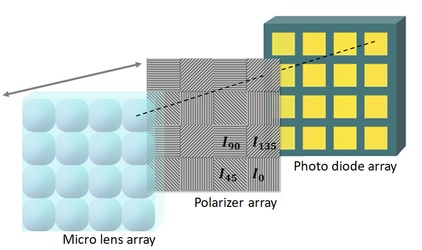A brand new camera for polarization studies is now part of the equipment of Solar and space weather research group at the Institute of Astronomy and NAO. It has been purchased earlier in 2021 as part of the project “Research on active solar processes during and beside total solar eclipses”, funded by the National Science Fund. The SVS-VISTEK exo250Z camera (https://www.svs-vistek.com/en/knowledgebase/svs-about-machine-vision.php?p=polarized_en-893#the-physics) series utilizes the newly developed IMX250MZR Sony sensor based on the popular pixel, 2/3” IMX250 CMOS sensor with 3.45µm pixel size. A four-directional polarization square filter array is overlaid directly on top of the pixel array and beneath the micro lenses. This filter consists of repeated 2×2 patterns consisting of grid polarizers with four different angles at 0°, 45°, 135° and 90° (Figure 1). Each polarizer filters the incoming light such that only the polarization components perpendicular to the grid orientation can pass through and be detected by the underlying photo diode. Thus, a four directional polarization image can be captured in one shot.

Figure1. 2×2 filter array with 4 polarization grid orientations.
Our team plans to use the camera for studying the polarization of white-light solar corona during the next expedition for observations of total solar eclipse(possibly in April 2023 in Australia).
Ground-based total solar eclipse observations are still the key method for coronal investigations. As of the eclipse in 1871, we know that the light from the solar corona is strongly polarized. The question about its white-light degree of polarization remains unanswered. Some anomalies in values of the degree and angle of polarization are the reason to continue looking for answers to the questions on physical mechanisms that define their nature. There are hypotheses claiming that the degree of polarization in certain regions of the corona may be higher than the maximal theoretically predicted value determined by Thomson scattering.
Our team performed similar experiments during 4 total solar eclipses – in 1999, 2006, 2017 and 2019. Now we test the opportunity to use for the first time for scientific purposes the new camera introducing a new time saving and error reducing method to improve our results.
